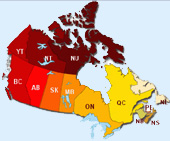 Canadian youths are faring better than their OECD counterparts as concerns the labour market. Numbers for the 1997–2007 period were excellent: 59.5% for the employment rate among those aged 15 to 24 in 2007 vs an OECD average of 44%. In ten years, the youth unemployment rate plunged from 16% to 11%, also better than the OECD average (13% in 2007). The long-term youth unemployment rate in Canada is particularly low, at 2% vs 20%!
Canadian youths are faring better than their OECD counterparts as concerns the labour market. Numbers for the 1997–2007 period were excellent: 59.5% for the employment rate among those aged 15 to 24 in 2007 vs an OECD average of 44%. In ten years, the youth unemployment rate plunged from 16% to 11%, also better than the OECD average (13% in 2007). The long-term youth unemployment rate in Canada is particularly low, at 2% vs 20%!
Canada is also a leader in terms of the proportion of students at the postsecondary level, with the highest OECD percentage. The high school dropout rate is very low too: 8.7% in 2005, vs 13% for OECD countries.
Many factors explain these good results, including sustained economic growth and a very flexible labour market. In addition, relaxed job protection legislation means that employers are more inclined to hire young people at relatively low wages. They advance quickly, and their salaries rise quickly too, but while combining school and work may appear to be a good thing, over the long term too many hours of work may encourage youth to drop out.
This is why the government has decided to give young people extra help. In mid-June, it implemented a long-term economic plan with the objective of providing the country with the most qualified, best educated and most flexible labour force in the world. To do this, the government and donor employers will invest $11.3 million to link highly specialized young Canadians with potential employers, in addition to providing a financial contribution to young post-secondary graduates in key sectors. The program should create high-quality jobs for at least 406 young post-secondary graduates and provide them with experience to build their careers.
Finally, despite its excellent showing, Canada could still do better. Some minorities, particularly youth in rural communities and Aboriginal youth, are at a greater disadvantage in the job market than "regular" candidates.